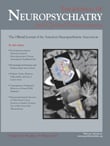When qEEG Gets Personal: A Reply to Coburn et al. (2006)
To the Editor: In 2006 this journal published a review by Coburn et al. 1 on the value of quantitative EEG in psychiatry, with emphasis on “the individual patient sitting across the desk…” of the clinical psychiatrist.
Unfortunately, in spite of its didactic goal, this review mainly focused on how efficiently patients can be classified using combinations of qEEG measures in discriminant functions, and the epic saga of the battle between “believers” and “nonbelievers” in neurometrics (Court struggling and personal allusions included), but little is clarified about which medical meaning has a “statistically abnormal” qEEG measure, as is clear in the meaning of a hypodense or hyperdense zone in an MRI, in spite of “the more complex mathematics involved.”
Apparently as a part of the above-mentioned struggle, a paper 2 published by our group with the goal of ascertaining the value of some qEEG measures as markers of pathology was targeted by Coburn et al. 1 as a paradigm of the methodological flaws suffered by qEEG, but several important facts were neglected in their criticisms.
First, the authors complained about our normative database and statistics because we found “abnormalities” in eight of 67 healthy subjects using the familiar Z-transform. However, they omit that those “abnormalities” were due to atypical features easily identified in their background EEG. Nevertheless, some paragraphs before, they stated that qEEG “… may be sensitive to statistically significant but clinically trivial normal variants.” 1 But in that case they did not consider it “ill-advised” to use the method. A double standard? They also neglected our findings of alterations with 100% specificity, like decrease in slow bands, and their association with brain atrophy.
Second, they criticize our inability to find explicit correspondence between specific qEEG alterations and diagnosis, due to our “inadequate database” and our “rejection of discriminant functions.” Since our paper dealt with a study of qEEG features in blindly selected cases with a posteriori correlation with clinical data, we could not expect to have proportional representation of all diagnostic categories, but a bias toward the most frequent. However, we agreed in that “there was a significant statistical trend for some patterns … to be more frequently observed in some disorders.” 2 Coburn et al. 1 neglected this observation.
The objection about the use of “hypernormals” instead of “street normals” in our database is indeed ill-advised, since there is evidence of specific qEEG alterations reflecting incipient brain dysfunction in patients who are “in the streets” with medical conditions like diabetes and hypertension without any neurological or psychiatric complaints. 3
In summary, we feel that qEEG will remain stranded in the realm of personal beliefs and group feud until we can obtain enough knowledge about the medical meaning of the numbers involved here, like in any other diagnostic test. 4 One must also wonder if “diagnostic classification” should be the main goal of qEEG. Is even a 90% specificity in a discriminant function enough in an age when the 10% misdiagnosed patients can have easy access to all the information concerning the misdiagnosis we or the machine is giving them?
1. Coburn KL, Lauterbach EC, Boutros NN, et al: The value of quantitative electroencephalography in clinical psychiatry: a report by the Committee on Research of the American Neuropsychiatric Association. J Neuropsychiatry Clin Neurosci 2006; 18:460–500Google Scholar
2. Coutin-Churchman P, Añez Y, Uzcategui M, et al: Quantitative spectral analysis of EEG in psychiatry revisited: drawing signs out of numbers in a clinical setting. Clin Neurophysiol 2003; 114:294–306Google Scholar
3. De Quesada-Martínez ME, Blanco-García M, Díaz-De Quesada L: [Early functional disorders of the brain in uncomplicated hypertensive patients.] Rev Neurol 2005; 40:199–209 (Spanish)Google Scholar
4. Alper KR, John ER, Brodie JR, et al: Correlation of PET and qEEG in normal subjects. Psychiatry Res Neuroimaging 2006; 146:271–282Google Scholar



